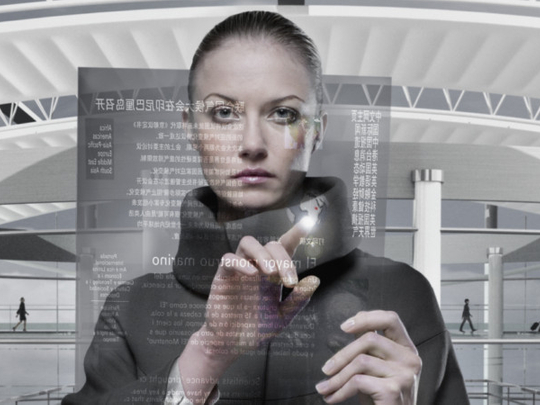
As one of the estimated 25 million visitors travelling to Expo 2020 in Dubai (should it win the bid), if you look lost when finding your way around the Al Wasl open plaza or the three zones of the 438-hectare site, many things may happen.
To start with, facial recognition technology equipped with the ability to interpret brainwaves and emotion may prompt an immediate response. Somewhere in the organisers’ office an algorithm will take over to help you navigate the complex with the help of an internal GPS map on your own smart device, with the places you want to visit already marked on it, based on the profile you shared on signing up. Or the walls, with built-in near field communication (NFC) capabilities, may start talking to you in your own language.
Device central
“We are very focused on BYOD (bring your own device). The phone is a conduit and a portal through which people will connect [at events in the near future]. Most people would be bringing their own device. This means that the event will be carbon-neutral. Saving paper is in tune with the vision,” says John Quinn, Presentologist, Satellite Visual Communication, who is working on several technologies for audience engagement.
Technology and innovation have long been high points of World Expos. The first Expo in the US in 1876 introduced the telephone and the commercial typewriter. Back in the last century, the first edible ice-cream cone was introduced at Expo 1904 in St Louis. The first mobile phones were exhibited in Expo 1970 in Japan.
In the souq-inspired exhibition halls of Expo 2020, when you bump into an innovator, chances are you will exchange business cards by simply transferring them to each other’s devices. The future of meetings, experts say, may be here faster than expected.
The International Centre for Research in Events, Tourism and Hospitality at Leeds Metropolitan University recently conducted a study, Technology: Why Invest and What’s Next? for the industry body, Meeting Professionals International (MPI). “Meetings professionals may think that avatars, augmented reality and artificial intelligence are the stuff of sci-fi fan fiction, but these technologies could soon revolutionise meetings,” the study’s authors write.
Experiential data
For the hosts, the challenges are implementing the right technology which is reasonably future-proof. One of the themes of Dubai Expo 2020 is mobility, which weaves into the fabric of the design, where state-of-the-art computers, central and logistics systems are provided.
“The likelihood is that in the longer term we will need more systems to analyse data. We are managing far more data on experiences, meetings and sales than we have had before. We are likely to use more algorithms built into the system that allow us to respond without investing in staff resources,” says Jackie Mulligan, the author of From the Outside In: The Future of Meetings, a study by MPI Foundation, while speaking to GN Focus.
Key technological innovations are the enabling of NFC and the creation of touch screens. “Surfaces are going to be very important. All surfaces will become screens. NFC means that different people can scan and pick up information. They can tag exhibits that they are interested in with their phones. Those infrastructures need to be put in place now,” says Quinn.
The future of meetings sees communication as crucial at the event for its success. International data plans that cost too much, dropped calls and waiting to get to the room to access the day’s emails would be relegated to old days. “Data access is critical. How are they going to connect with bandwidth? People need to be given data capacity, so service providers will be critical here,” says Quinn.
MPI’s research visualises meetings in 2030. However, whether the future is seven years or seventeen years away, it does not require regular meetings professionals to transform into geeks. Experts say that those who understand both the needs of the audience and the technology are likely to have an edge.
“The future will require meeting professionals to understand people, their differences and their needs in terms of face-to-face communication and data will lead the charge,” says Mulligan.
Facial recognition
Whether it is with facial recognition or with connecting people, the message to the audience is that each one matters. “We are working with neural frequencies the same way you get an ECG and heart readings. This will tell us if they are really engaged in the event. Facial recognition is already available where you can scan up to 2,000 people per second. So neuro frequency is the next thing to truly engage people at live events,” says Quinn.
Research speaks of a personal sharing economy where people will share more in exchange for rewards. Mulligan says that delegates will be sharing more information with meetings organisers in return for better personalised experiences. For organisers, this means responding in real time to problems that crop up in a meeting.
“If your delegates have left with a bad feeling it is too late then. In the future they will be required to respond quickly. Meetings organisers will have far more responsibility for networks to be established for a longer period of time,” Mulligan says.
Quinn brings networking to real life. He says, “We are trying to create audience dashboards so organisers can engage with the audience. We are profiling people so that they can meet other like-minded people. It’s like business dating.”













